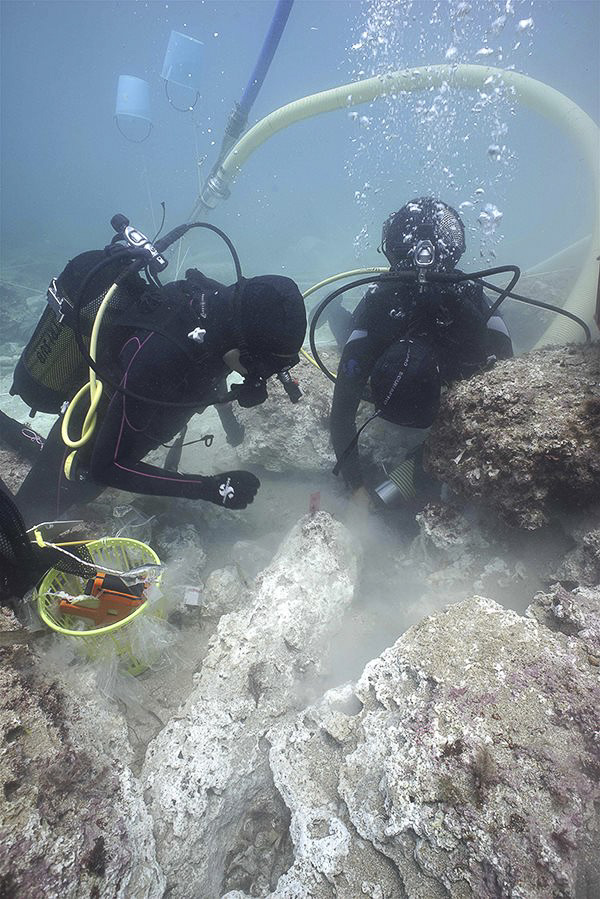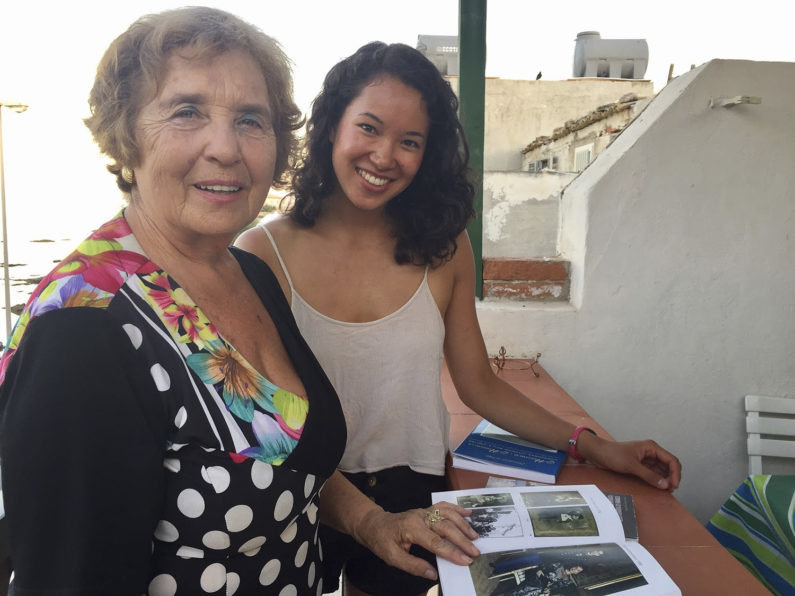Stanford senior explores how ancient ruins in southeastern Sicily affect identities
Throughout history, many groups, including ancient Greeks and Romans, have colonized the island of Sicily. Stanford senior Madeleine Ota researched how remnants of those classical civilizations affect the lives of local residents today.
Every morning last summer, Stanford senior Madeleine “Elle” Ota donned heavy scuba gear and dived to the bottom of the Mediterranean Sea to excavate remnants of an ancient Roman shipwreck.

Stanford students Madeleine Ota, left, and May Peterson search through the ancient remnants of a sixth-century Roman shipwreck underwater near the coast of Marzamemi, Italy. (Image credit: Marzamemi Maritime Heritage Project)
Back on land, Ota brought a plastic basket, filled with pieces of pottery and stone she found, to her research team. And then, with a notebook in hand and a translator by her side, Ota walked around the nearby Sicilian village to ask residents what the artifacts from ancient civilizations in the area said about their local history and sense of identity today.
This was a typical day for Ota during her quarter abroad in southeastern Sicily, Italy. She was there to help excavate a sixth-century Roman shipwreck for the Marzamemi Maritime Heritage Project, an archaeological effort led by Stanford Assistant Professor of Classics Justin Leidwanger since 2012. This research, combined with interviews of local residents, formed Ota’s undergraduate thesis project.
“Archaeology isn’t only digging into the past, but it’s also about preserving things for the present,” said Ota, who is double majoring in classics and archaeology and will pursue a master’s degree in anthropology through Stanford’s co-term program. “But I think too often archaeologists do their work and dig for artifacts without asking how those objects affect the people who live around archaeological sites. And I wanted to bring the focus of archaeology to the people it affects.”
Ota is one of several Stanford students who have accompanied Leidwanger and other researchers each summer to Marzamemi, a small village on the southeastern coast, to excavate a Roman vessel that sank sometime in the 600s while carrying materials to build a church.
Ota dived 25 feet underwater to help search for chunks of marble and other stone intended for the church’s construction. Researchers say Roman Emperor Justinian sent out ships like these to help promote Christianity across the Mediterranean.

Stanford student Madeleine Ota, right, interviews Giuseppina Aliffi, a local historian in Marzamemi, Italy, as part of her research project in summer of 2017. (Image credit: Courtesy Madeleine Ota)
Over her six weeks in Sicily, Ota went to Marzamemi’s historic town square to talk with locals about how the objects she excavated – remains of an ancient civilization – might affect them today. She asked residents questions like “Do you feel that the classical world is important to this area’s history?” and “Which aspects of Marzamemi’s history are most important to you?” In total, she interviewed almost 40 residents.
Throughout its history, Sicily has been colonized by many groups across the Mediterranean Sea.
But Ota found that most people in the Marzamemi area felt their history and way of life were connected to ancient Greek culture rather than, for example, the Romans, who are often associated with the country of Italy.
“This part of Sicily is really the nexus of the Mediterranean, with influences from northern Europe, northern Africa, Spain, Greece, Italy and others,” Leidwanger said. “It’s a place where you could pick and choose your cultural influence. So why is it that people connect with different aspects of that past, and what is it that they don’t connect with?”
The residents Ota spoke with said they believe that they inherited their maritime practices, moral values and dialect from the ancient Greeks. Some of them pointed to the historical significance of Syracuse, a famous ancient Greek city founded in the eighth century BC about 30 miles away from Marzamemi.
“Everyone I talked to had this idea that their history begins with the Greeks, although there were plenty of indigenous people living on Sicily before that time,” Ota said. “It’s been really interesting to figure out how Greek history plays into Marzamemi’s past.”
Ota said it’s important for archaeologists to understand how people today construct their identities in relation to the ancient artifacts and ruins around them.
I think if we can better learn how to manage cultural heritage globally and foster understanding of each other’s backgrounds, we can build a lot of respect and collaboration among individuals.
Madeleine Ota
Stanford senior
“I believe we have a responsibility not only to the materials themselves but also to the modern populations whom they affect,” Ota said. “Studying classical heritage in the context of modern communities can help us understand how the world engages with the classical past and how archaeologists can handle these materials in positive and ethical ways.”
Leidwanger said Ota’s work will help his team as it continues to do public outreach in the area. In addition to the excavation work, the Marzamemi Maritime Heritage Project partners with the local community on heritage preservation and tourism in the area. For example, Leidwanger is working on a multimedia exhibit for communities in the Mediterranean to showcase what maritime travel was like hundreds of years ago.
“It’s been exciting to watch Elle’s project develop,” Leidwanger said. “She has done a remarkable job, and her work is going to help guide us as we continue to develop connections between the local communities and our archaeological work.”
Ota is interning with UNESCO in Paris this summer, and she said she hopes to continue to work on different heritage projects around the world to bring people from different backgrounds together. She will return to Stanford in the fall to complete a master’s degree.
“So many conflicts in this world are caused by people not understanding each other and their past,” Ota said. “I think if we can better learn how to manage cultural heritage globally and foster understanding of each other’s backgrounds, we can build a lot of respect and collaboration among individuals.”
